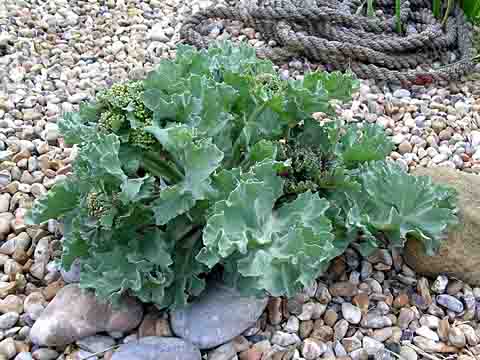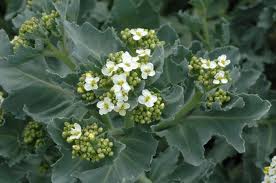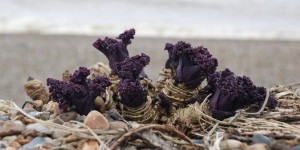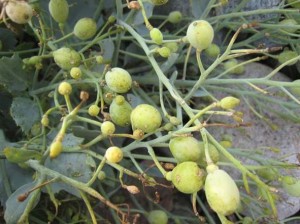Sea kale is nearly the perfect primitive food. It’s difficult to imagine it not being on primitive man’s menu.
We know from middens that seafood was very popular with ancient peoples. Archaeologists think early man stayed on the shore because there is so much food there. Some coastal Indians of Alaska have a saying which in modern terms means: When the tide is out the dinner table is set. And while humans were foraging for clams, crabs, fish and other seashore edibles there was sea kale. The root is very nutritious and edible raw or cooked though more calories are available when cooked. The leaves are also nutritious and make a salad ingredient or pot herb. The plant, which lives about a dozen years, makes an extensive root system with a lot of small roots that are easy to dig up. The root tastes good raw or cooked, has more starch than potatoes and some protein as well. The roots also travel well. Eat it today, or tomorrow, or a few days from now. It’s the original take out food.
Sea kale is mentioned in some of the earliest references to food. The Romans preserved it in barrels for sea voyages. Its high vitamin C content prevented scurvy. Sea kale was cultivated in Europe from at least the 1600s until around WWII. Even Thomas Jefferson raised some in 1809. It’s been having a comeback of late in European restaurants. As for ways to eat it, Cornucopia II says on page 58:
“The blanched leafstalks are eaten raw in salads, boiled, baked, braised or otherwise prepared as asparagus. When properly cooked they retain their firmness and have a very agreeable flavor, somewhat like that of hazelnuts, with a very slight bitterness. The leaves can be boiled until soft, minced, seasoned with garlic, and served as spinachy. Plants can be forced indoors for winter use. “ There is one cultivar, Lily White. Other common names are blue seakale, sea-colewort, scurvy grass, and halmyrides.
There are also two other species, Crambe orinetalis and Crambe tataric. C. orientalis has a very thick root that is used as a substitute for horseradish. Young flower stalks can be prepared like broccoli. The seeds have an edible oil. C. tatarica’s young leaves are are blanched and eaten raw or cooked. Its root is thick and sweet and is eaten raw in salads or cooked, often seasoned with oil, vinegar and salt.
In the cabbage clan, botanically sea kale is Crambe maritima (KRAM-bee mare-rah-TEE-mah.) Crambe is from the Greek “Krambe” meaning cabbage or crucifer. Maritima means oceanside. While the plant can tolerate salt and grows happily on the beach it can be raised in regular gardens. In the common garden it takes about 100 days to reach maturity.
Green Deane’s “Itemized” Plant Profile: Sea Kale
IDENTIFICATION: Crambe maritima, a perennial to about three feet tall and wide, leaves fleshy, smooth with purple veins, deeply lobes, wavy edges, hardy to zone 5 or colder, not frost tender, can be a summer crop down to about zone 8, flowers from June to August, self-fertile.
TIME OF YEAR: Any time it is found. In the garden it’s slow to grow. While it can be eaten the first season it is best left alone until the third season. It will produce for about 10 years.
ENVIRONMENT: Found growing on the shore, coastal sands, in rocks, on cliffs, often near on the drift line. While most common in Europe it is naturalized on the coasts of California and Oregon and in many ornamental gardens.
METHOD OF PREPARATION: Many. The entire plant is edible raw or cooked, roots, shoots, stems, leaves, flower buds, pods. Young shoots are harvested when four or five inches long, crisp, and tender before leaves start to expand. Do not confuse sea kale with sea-kale cabbage, which is a different vegetable altogether.
Here’s a 37-second video showing Sea Kale. There’s no words or music but turn down your volume because of wind noises.






I’ve never seen it in Seattle (I lived there for 14 years). It’s pretty common on beaches in the Mediterranean and Black Sea
I found it on the beaches of Felixstowe (Suffolk in UK)
and I cooked it like cabbage for dinner. Lovely. Tasted somewhere between cabbage and kale
A success story…
Hi U Martin,
I am so pleased I’ve just found this comment regarding sea kale/cabbage.
My husband and I went to Felixstowe yesterday for the day and while walking along the front came across this veg. I picked it, just researched it and seen your text, I’m going to steam and try it tonight.
Thank you.
I live in Seattle. I have not seen it growing wild, but I do have it in my garden. Unfortunately I don’t remember where I originally got it. It was either Seattle Tilth or an online nursery.
I have successfully grown this from seed that I purchased from J.L. Hudson Seedsman (out of California). http://jlhudsonseeds.net/ I’ve never actually seen plants for sale but I was out near the Yaquina Head Lighthouse on the Oregon Coast a month or two ago and saw it growing there along the shore at the base of a cliff. I’m not suggesting you dig up a plant but perhaps you could harvest the seed. Doublechecking with the folks there at the lighthouse might be a good idea, too. 🙂
Where can we buy some seed?
Is anybody able do give us notice?
many greetings from horst and heidrun hiller (germany)
You can get them here:
http://www.kraeuter-und-duftpflanzen.de/Nach-Verwendung/Strandkraeuter/Meerkohl-Saatgut
They also sell plants.
Hi,
Seeds for seakale, Lilywhite, can be ordered from more veg dot co dot uk. We have successfully grown it in Ireland. It is a wonderful plant, versatile, and a great talking point at the dinner table because hardly anyone else knows about it. MoreVeg will post to Europe.
Margaret.
I was able to obtain a now thriving sea kale from Food Forest Farm in Massachusetts (permaculturenursery.com), they ship in spring and sell out quickly. Thanks, Green Deane for all of this terrific info on what has become one of my favorite perennial edibles!
Does anyone know if the sea kale will grow well in Florida? Appears it doesn’t like cold like regular kale so I would guess so.
Sea kale likes colder waters, but sea lettuce grow happily here.
In New England we didn’t harvest kale until after it got chilly in the fall. Like other Brasilia. Now, however we are using kale from spring right into freezing and snow covered. During the warm time of the year some of us freeze kale to make it sweeter.
I am an investor in Mauritania in the area of agriculture, I have 1000 000 hectar next to the Atlantic Ocean am looking for a partner
Of potato cultivation in saline Areas.
Seakale (Crambe maritime) was a common vegetable sold on the open the open market during the Victorian period noted by Henry Mayhew.
Hi To You”
My husband and I love eating seakale – it’s particularly nice when It is prepared. This entails washing it first then breaking the leaves into small pieces, then add a sprinkling of raw sea salt, rub-well into the leaves, cover with a cloth and leave until ready to be cooked. Best dropped into boiling water.
INCIDENTALLY” Can anyone Confirm that it is OK to freeze C-Kale for the FREEZER?
Is it best to cook it first’ and for how long should one cook it before freezing it?
Just had a plateful harvested from out front of the family chalet at Branscombe UK. Blanched the fried in butter, salt, pepper and chilli, bloody lovely.
Thanks for the all the great information. Hope you don’t mind me pointing out that It would have been really usefull to see a picture of sea kale cabbage, as you said not to confuse the two. Sea kale is very common and easy to identify, sea kale cabbage doesn’t even come up in a web search, all the sites just got to see kale as it is a cabbage.